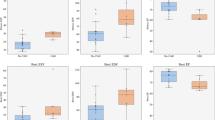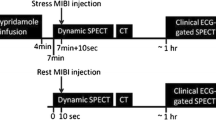Abstract
Advanced coronary artery disease, defined as left main or three-vessel coronary disease, was identifiable noninvasively by means of adenosine Tl-201 single photon emission tomography. Among 75 consecutive patients with angiographically documented coronary artery disease, there were 11 patients with the presence (group 1) and 64 patients with the absence (group 2) of advanced coronary artery disease. The lung-to-heart ratio (L/H ratio) of Tl-201 uptake was calculated as the fraction of average Tl-201 counts per pixel in the lung divided by those in the myocardium. The left ventricular dilation ratio (LVDR) was determined as a ratio of left ventricular cavity size in the early image to that in the delayed image. The patients in group 1 had more defects (2.3 ± 0.6 seg. vs. 0.9 ± 0.7 seg., p < 0.001), ahigher L/H ratio (35 ± 4% vs. 28 ± 5%, p < 0.001) and a higher LVDR (1.13 ± 0.04 vs. 1.06 ± 0.04, p < 0.001) than those in group 2. The diagnostic accuracy of the identification of advanced coronary artery disease was 89% by perfusion defects, 68% by L/H ratio and 81% by LVDR. Stepwise discriminant analysis revealed that LVDR (F = 36.2, p < 0.0001) and perfusion defects (F = 8.9, p < 0.004) were the significant and independent discriminators of advanced coronary disease.
Identification of patients with left main or three-vessel coronary disease was enhanced by additional analysis of cavity dilation of the left ventricle and increased Tl-201 activity in the lung.
Similar content being viewed by others
References
Moser GH, Schrader J, Deussen A. Turnover of adenosine in plasma of human and dog blood.Am J Physiol 256: C799-C806, 1989.
Christensen CW, Rosen LB, Gal RA, Haseeb M, Lassar TA, Port SC. Coronary vasodilator reserve. Comparison of the effects of papaverin and adenosine on coronary flow, ventricular function, and myocardial metabolism.Circulation 83: 294–303, 1991.
Lerman B, Belardinelli L. Cardiac electrophysiology of adenosine. Basic and clinical concepts.Circulation 83: 1499–1509, 1991.
Verani MS, Mahmarian JJ, Hixson JB, Boyce TM, Staudacher RA. Diagnosis of coronary artery disease by controlled coronary vasodilation with adenosine and thallium-201 scintigraphy in patients unable to exercise.Circulation 82: 80–87, 1990.
Verani MS, Mahmarian JJ. Myocardial perfusion scintigraphy during maximal coronary artery vasodilation with adenosine.Am J Cardiol 67: 12D-17D, 1991.
Iskandrian AS, Heo J, Nguyen T, Lyons E, Paugh E. Left ventricular dilatation and pulmonary thallium uptake after single-photon emission computed tomography using thallium-201 during adenosine-induced coronary hyperemia.Am J Cardiol 66: 807–811, 1990.
Iskandrian AS, Heo J, Nguyen T, Beer SG, Cave V, Ogilby D, et al. Assessment of coronary artery disease using singlephoton emission computed tomography with thallium-201 during adenosine-induced coronary hyperemia.Am J Cardiol 67: 1190–1194, 1991.
Dash H, Massie BM, Botvinick EH, Brundage BH. The noninvasive identification of left main and three-vessel coronary artery disease by myocardial stress perfusion scintigraphy and treadmill exercise electrocardiography.Circulation 60: 276–284, 1979.
Rigo P, Bailey IK, Griffith L, Pitt B, Burow RD, Wagner HN, et al. Value and limitations of segmentai analysis of stress thallium myocardial imaging for localization of coronary artery disease.Circulation 61: 973–981, 1980.
Maddahi J, Abdulla A, Garcia EV, Swan HJC, Berman DS. Noninvasive identification of left main and triple vessel coronary artery disease: Improved accuracy using quantitative analysis of regional myocardial stress distribution and washout of thallium-201.J Am Coll Cardiol 7: 53–60, 1986.
Kushner FG, Okada RD, Kirshenbaum HD, Boucher CA, Strauss HW, Pohost GM. Lung thallium-201 uptake after stress testing in patients with coronary artery disease.Circulation 63: 341–347, 1981.
Kaul S, Lilly D, Gascho J, Watson D, Gibson R, Oliner C, et al. Prognostic utility of exercise thallium-201 test in ambulatory patients with chest pain: comparison with cardiac catheterization.Circulation 77: 745–758, 1988.
Kurata C, Tawarahara K, Taguchi T, Sakata K, Yamazaki N, Naitoh Y. Lung thallium-201 uptake during exercise emission computed tomography.J Nucl Med 32: 417–423, 1991.
Weiss AT, Berman DS, Lew AS, Nielsen J, Potkin B, Swan HJC, et al. Transient ischemic dilation of the left ventricle on stress thallium-201 scintigraphy: a marker of severe and extensive coronary artery disease.J Am Coll Cardiol 9: 752–759, 1987.
Takeishi Y, Tonooka I, Ikeda K, Komatani A, Tsuiki K, Yasui S. Dilatation of the left ventricular cavity on dipyridamole thallium-201 imaging: A new marker of triple-vessel disease.Am Heart J 121: 466–475, 1991.
Takeishi Y, Tonooka I, Meguro M, Hoshi H, Masakane I, Ikeda K, et al. The relationship between chest pain during thallium-201 scintigraphy with dipyridamole and myocardial ischemia.Jpn Circ J 55: 465–472, 1991.
Takeishi Y, Tonooka I, Kubota I, Ikeda K, Masakane I, Chiba J, et al. Functional recovery of hibernating myocardium after coronary bypass surgery: Does it coincide with improvement in perfusion ?Am Heart J 122: 665–670, 1991.
Takeishi Y, Tonooka I, Chiba J, Abe S, Tsuiki K, Tomoike H. Simultaneous assessment of left ventricular wall motion and myocardial perfusion at rest and during exercise by trechnetium-99m methoxy isobutyl isonitrile.Jpn Circ J 55: 1192–1199, 1991.
Takeishi Y, Chiba J, Abe S, Tomoike H. Ratio of lung to heart thallium-201 uptake on exercise and dipyridamole stress imaging in coronary artery disease: Implications of SPECT.Jpn Circ J 57: 379–387, 1993.
Wackers F. Adenosine or dipyridamole: Which is preferred for myocardial perfusion imaging ?J Am Coll Cardiol 17: 1295–1296, 1991.
Nishimura S, Mahmarian JJ, Verani MS. Significance of increased lung thallium uptake during adenosine thallium-201 scintigraphy.J Nucl Med 33: 1600–1607, 1992.
Iskandrian AS, Heo J, Lemlek J, et al. Identificantion of high-risk patients with left main and three-vessel coronary artery disease by adenosine-single photon emission computed tomographic thallium imaging.Am Heart J 125: 1130–1135, 1993.
Sugihara H, Shiga K, Umamoto I, et al. Assessment of transient dilation of the left ventricular cavity in patients with hypertrophic cardiomyopathy by exercise thallium-201 scintigraphy.Kaku Igaku 27: 1281–1289, 1990.
Gould KL. Noninvasive assessment of coronary stenosis by myocardial perfusion imaging during pharmacologic coronary vasodilation. I. Physiologic basis and experimental validation.Am J Cardiol 41: 269–278, 1978.
Gould KL, Westcott RJ, Albro PC, Hamilton GW. Noninvasive assessment of coronary stenosis by myocardial imaging during pharmacologie coronary vasodilation. II. Clinical methodology and feasibility.Am J Cardiol 41: 279–287, 1978.
Author information
Authors and Affiliations
Rights and permissions
About this article
Cite this article
Takeishi, Y., Chiba, J., Abe, S. et al. Noninvasive identification of left main and three-vessel coronary artery disease by thallium-201 single photon emission computed tomography during adenosine infusion. Ann Nucl Med 8, 1–7 (1994). https://doi.org/10.1007/BF03164980
Received:
Accepted:
Issue Date:
DOI: https://doi.org/10.1007/BF03164980




